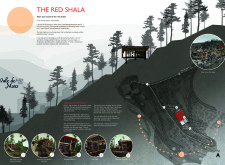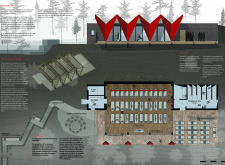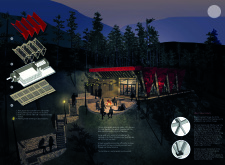5 key facts about this project
The Red Shala is located in the Vale de Moses in Portugal, where it serves as a space for yoga and meditation. The design aims to create a sanctuary that promotes both mental and physical renewal. The building stands out with its vibrant vermilion canopy, which contrasts with the lush forest surrounding it. The overall concept reflects an intention to form a strong bond with nature, providing users a place to reconnect.
Conceptual Framework
The design of the Red Shala is based on the idea of creating a sacred space that encourages mindfulness. Triangular openings feature prominently in the structure, framing views of the sky and the landscape. This design choice allows ample natural light to enter, enhancing the serene atmosphere within. Users are invited to feel both open and protected in the space, creating a calming environment.
Structural Design
Glulam portal frames make up the primary structure, employing diagonal bracing to manage lateral loads effectively. This method ensures that structural forces are evenly distributed, reducing the need for internal supports and allowing for a more flexible layout. The glulam beams add to the visual appeal of the interior while reinforcing the overall stability of the building.
Material Selection
Expanded cork is integrated throughout the Red Shala as an insulation option. This material is chosen for its lightweight and hypoallergenic properties, as well as its ability to absorb sound. Using cork supports sustainability, drawing from local resources. The roof features glazed ceramic tiles, which add a traditional touch and connect the building to Portuguese architectural heritage.
Functional Organization
The layout is designed to facilitate smooth movement and interaction among users, accommodating groups ranging from 18 to 36 participants comfortably. An outdoor deck and a meditative area are positioned to take advantage of sunlight throughout the day. These spaces allow for diverse activities, fostering an engaging atmosphere where users can practice and reflect.
As light filters through the triangular openings, it creates shifting patterns within the practice area, contributing to the tranquil environment.






















































